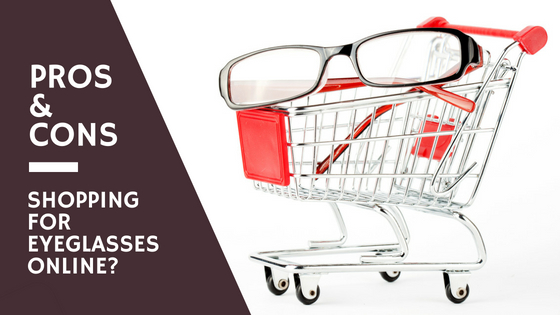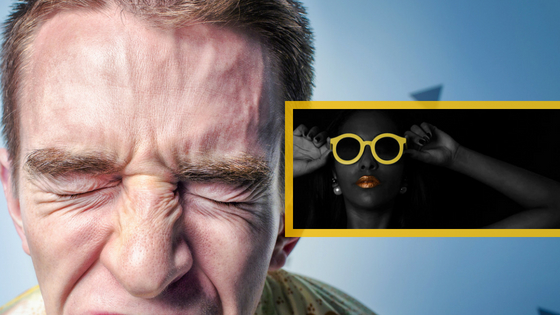Pros and Cons of Buying Prescription Eyeglasses Online

Online shopping has taken a lot of hassle out of our daily lives. Perhaps the thought of buying your next pair of prescription eyeglasses online might even sound appealing.
You wouldn’t have to deal with a crowded shopping area or long lines when you got to the optician’s office. So let’s take a look at some of the pros and cons of ordering prescription eyeglasses via the internet.
Pros:
- The biggest advantage to buying online is the cost. It is possible that online shopping could save you up 40% of the total cost of new eyeglasses.
- You can search through several websites and have your pick of thousands of frames.
- Once you’ve made your decision, insert all the required details about your eyes and method of payment, and that’s it.
Cons:
- You need to accurately measure the distance between your pupils, which is extremely difficult to do.
- Online services cannot test for eye health.
- The frames will not be adjusted to fit your head and face when purchased online.
- Progressive lenses and bifocals have too many variables in the prescription, so it is not advisable to order them without professional assistance.
An investment in your health
Although eyeglasses frames come in a vast variety of colours, styles and sizes, purchasing a pair of prescription eyeglasses should be much more than a fashion statement. You certainly want to find a pair of frames that look good on you, so going into the optician and trying the frames on is a wise idea.
You also need to find out if the frames work well with the lenses you’ve chosen. A small frame could make you look very interesting, but your prescription might not fit into such small lenses. You’ll get a warped, fish-eye view if the frames you choose are curved or wrap-around and your prescription has to be made into a curved lens. There are limits. It would also be a good idea to think about getting anti-glare and anti-scratch coatings for your lenses, but you may need to talk to an optician to know which options are best.
Seek out an optician
Buying prescription eyeglasses is a serious investment. For instance, if you try to measure the pupil distance yourself, a small mistake could end up causing eye strain and headaches. An optician can tell you if the frames and lenses are a good fit for each other and you.
Not only will an optician make the initial measurements, but will also adjust your eyeglasses once they arrive. When there is a need, you can take your prescription eyeglasses in for an adjustment. You can’t do that over the internet!
For excellent, professional service from a well-trained local optician, contact Eye World today to set up an appointment. We invite you to give us a call at 902-465-4979 or submit the sidebar form on this page to get priority booking. We look forward to discussing your eyeglasses needs with you.
Stop Squinting & Save Your Eyes with Prescription Sunglasses

If you’re squinting in the sun because you bought those drugstore fit-over sunglasses or cheap clip-ons then you’re likely causing damage to your eyes and vision.
You may know that sunglasses protect your eyes against the sun’s UV rays. But have you ever considered that not all sunglasses give you the good protection? You can find thousands of glasses in department stores which claim to “block UV rays.”
To save your vision from serious damage choose sunglasses that offer 100% protection from UV rays. With cheap sunglasses, you may find that you’re still squinting and straining to see.
Whether you need prescription sunglasses or not, consider investing in high-quality sunglasses that will save your eyes from serious damage.
UV Protection
Ultraviolet rays from the sun will weaken your eyes. It can also hurt your eyelids. UV rays can bring on the development of cataracts and macular degeneration.
To protect your eyes from damaging UV rays, ask for prescription sunglasses that block 99-100% of UVA and UVB rays. You should request lenses that protect your eyes from 75-90% of all visible light.
Polarized Lenses versus Transition Lenses
Both of these lens-types are practical for your eyes. Polarized lenses eliminate the glare reflected from light sources onto all surfaces like water, snow and ice, the light that comes through your windshield or that bounces off the hood of your car.
A problem that can occur with polarized lenses is the filter that protects against glare can also block your ability to read certain electronic lights including some dashboard lights and your cell phone. It can prove dangerous if you don’t see a patch of ice your about to drive over or cannot read your car’s speedometer.
Transition lenses turn dark when you’re outside, so they save you the trouble of needing a second pair of prescription glasses.
A problem some people experience with them is that it takes one or two minutes before they to return to clear lenses when you go indoors. A bigger difficulty is when a car’s windshield blocks UV light from getting into the car, it will also keep the transition lenses from becoming dark.
Tinted Lenses
Coloured lenses can be much more than a fashion statement. Each colour can reduce glare, improve your ability to see contrasts, strengthen a person’s depth perception and reduce eye fatigue in various surroundings.
Tinted lenses can benefit the athlete and improve their performance in many sporting events.
Lens Coatings
When you’re looking for new sunglasses, think about the different coatings that are available.
A scratch-resistant coating will extend the life of your glasses and give you clearer vision.
Glare-resistant lenses will reduce your tendency to squint and strain your eyes due to the glare from oncoming car headlights, computer screens and other electrical devices.
A UV Protective coating will keep your eyelids from sunburn and protect your eye’s structure. This coating is crucial in saving your eyes from UV’s damaging rays.
Consider a Larger Frame
Even with good lenses, light from the sun can still reach your eyes in any place the frame doesn’t touch your face. Choosing a larger frame, thus, larger lenses will keep more of your eyes protected.
Buying glasses online might seem like a great deal. But if you have anything other than basic vision needs it might be a waste of time and money.
Not all prescriptions will work with every eyeglass frame. Making it a challenge to find a pair of sunglasses that will work with your prescription.
For some prescriptions, if the frame you like has a curve, the corrective focal point on your lense won’t be in that sweet spot. Things will look distorted.
Ask the dispensing optician at your eye doctor’s office for advice. They are the experts on eyeglass frame design, fit and corrective lenses. They’ll not only help you choose an attractive frame to suit your face shape, and lifestyle but they’ll know if the frames you picked will work for your specific prescription.
If you have vision questions or would like to make an appointment, please contact us at Eye World. Give us a call at 902-465-4979 or submit the online form on this page to get the next available eye exam appointment.
Bifocal vs Progressive Eyeglasses – Which Is Right For Your Vision?
Your eyesight can blur as you get older. This change in your vision is caused by the loss of elasticity of the lens. This is known as presbyopia; it is commonly associated with the aging process, typically appearing after the age of 40.
Your Vision Needs May be More Complex
As you age, you could learn that you need one prescription for near vision and an entirely different prescription to see clearly at a distance. You can accommodate both prescriptions with one pair of glasses by selecting bifocal or progressive lenses. To make an informed decision, you may need to know the similarities and differences between bifocal vs progressive eyeglasses.
What are Bifocal Lenses?
Bifocal lenses contain two focal points; the top half is intended to help you view objects at a distance. You will be viewing the world through the bottom half of your lens when you want to see objects that are close to you, such as when you are reading.
Traditional bifocal lenses have a distinct line, or possibly a “D” shape, visible on the surface of the lens. Some people view bifocal glasses as an indication of advancing age, so they resist wearing them.
What are Progressive Lenses?
Progressive lenses are more commonly referred to as “no-line” bifocals. Progressive lenses offer a smooth change of focus between the top and bottom of your lenses. The top of the lens adjusts your vision to see clearly at a distance, like the bifocal lens
Through the middle of the lens, your vision is adjusted to seeing at an arm’s length, with near vision clearest at the bottom center of the lens. While bifocals have two distinct focal points, progressive lenses are multi-focal, they have many.
Progressive glasses may take a little longer for you to adjust to than bifocals. It’s impossible to create a seamless multifocal lens without creating aberrations somewhere in the lens. For example; if you glance downward to the left or right, you may notice that your vision has blurred slightly. You may also notice feeling a bit “off” when you turn your head quickly.
Adjusting to Your Bifocal or Progressive Lenses
Whether you select progressive or bifocal lenses, you should plan on living with a brief adjustment period until looking through your new lenses becomes a habit. You will learn to adapt, and you will stop looking through the wrong area of the lens. Your minor vision issues should resolve within a few days of wearing your new prescription.
While adjusting to your new glasses, put your old glasses away. Switching back and forth can make adjusting to your new prescription more difficult. Your brain will adapt faster if you simply stick with your new lenses.
Even if you don’t notice any significant vision problems, It’s important to have your eyes examined every two years or every year after the age of 60. Routine eye exams can detect conditions that could threaten your vision, and your health, before symptoms are apparent to you. In Dartmouth, Novia Scotia, contact Eyeworld Ltd, to schedule your stress-free eye examination and learn more about the differences and similarities of bifocal vs progressive eyeglasses.
Choosing the Right Eye Glass Frame for Your Face & Style
When it comes to choosing a pair of glasses, most people try on different styles until they find something they like. The problem with this approach is that it takes time and can be quite frustrating, especially if you have no clue what you’re looking for. A better approach is to follow some basic guidelines that can help you narrow down your choices.
Face Shapes
The human face can come in many shapes and sizes. This is one of the biggest reasons why someone else’s eye glasses might look better on them than on you. The shape of your eye glass frames should contrast with the shape of your face, while their size should be in scale. Frames should also match your best feature, such as the color of your eyes.
While there are many variations, human faces can be narrowed down to a few basic shapes. The most common facial shapes are oval, round, oblong, square, diamond, base-up triangle and base-down triangle.
Oval faces are considered ideal, due to their balanced proportions. Frames that are at least as wide as the broadest part of the face will complement its natural symmetry. Walnut-shaped frames are also suitable, provided they’re not too deep or narrow. Glasses that cover too much of the face should be avoided.
Round faces require frames that make them look longer and thinner. Narrow, angular frames can add an appearance of length to the face some and a clear bridge can widen the eyes. Look for frames that are wider, rather than deeper, such as rectangular frames.
Oblong faces are longer than they are wide, with long noses and straight cheek lines. Deep frames can make oblong faces seem shorter. Decorative temples (arms) can contribute to the illusion of more depth and a low bridge can shorten the appearance of the nose.
Square faces feature broad foreheads and prominent jawlines, with equal proportions in width and length. Narrow frames with more width than depth can help lengthen the face’s appearance. Narrow ovals can soften the face’s angles.
Diamond-shaped faces appear narrower at both the eye and jawlines, with broad cheekbones. Frames with detailed or distinctive brow lines, rimless frames, or oval shapes work best with this rare facial shape.
The base-up triangle face is wide at the top and small at the bottom. Frames that are wider at the bottom help minimize the width of the top third of the face. Rimless frames are ideal and light colors work best.
The base-down triangle is essentially the opposite, with a narrow forehead and broad chin/cheek areas. Frames that are heavily accented with color along the top can help emphasize the top part of the face. Cat-eye shapes are also suitable for base-down triangle faces.
Skin Tone
In addition to the shape of your face, your skin tone can also help determine which types of eye glass frames look best. Skin tone has more impact on the appearance of your eye glasses than hair or eye color. Your best bet is to select a shade that closely matches your skin tone.
Lifestyle
Your way of life should also come into play, when choosing eyeglass frames. Give some thought to what types of activities you will be involved in, while wearing your glasses. For example, flexible frames are ideal for individuals with active lifestyles. If you’d like to look sharp at the office, you might want to look into styles that convey a sense of business savvy.
People often look to find the right contact lens for them as well as the best frames. Reason for this is lenses often are better during physical activity and then glasses are worn the rest of thet ime.
Personality
Your eyeglasses also serve as an expression of your personality. For this reason, some people like having one set to wear on weekends and another set for work. This allows you to select a more colorful set to express your fun-loving side when it’s appropriate, while still looking professional at the office.
As you can see, you don’t need fashion expertise to pick a pair of glasses that look good on your face. These tips help break the selection process down to key aspects that matter most. Keep in mind that these are just guidelines. It’s still up to you to choose the frames you’re most comfortable with.
For help finding the right eyeglasses for you and to ensure you have an up to date prescription connect with our optometrist in Dartmouth on Baker Drive.
